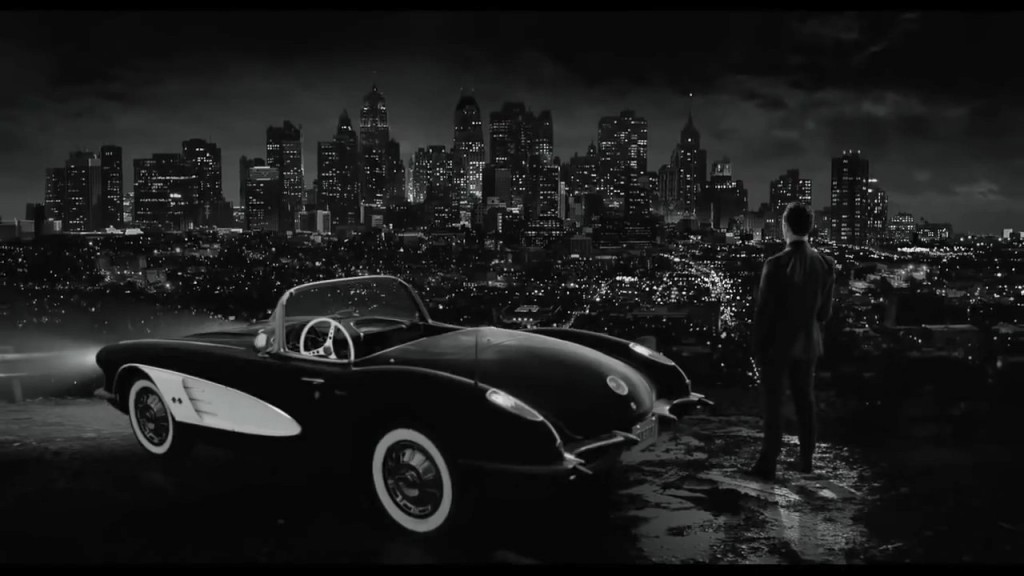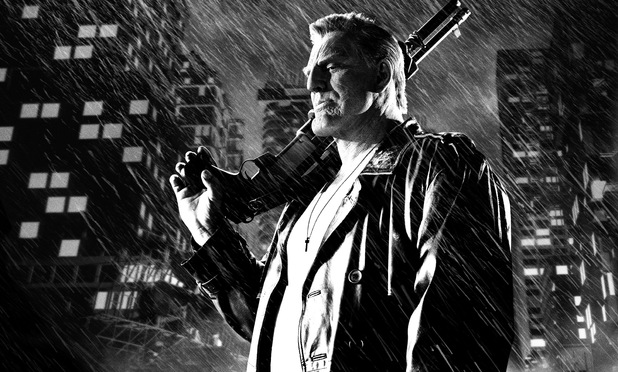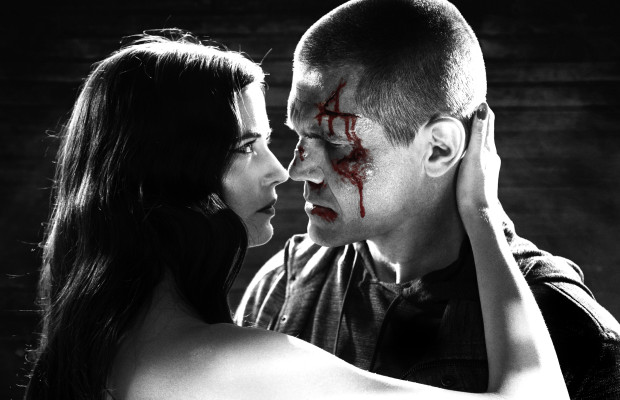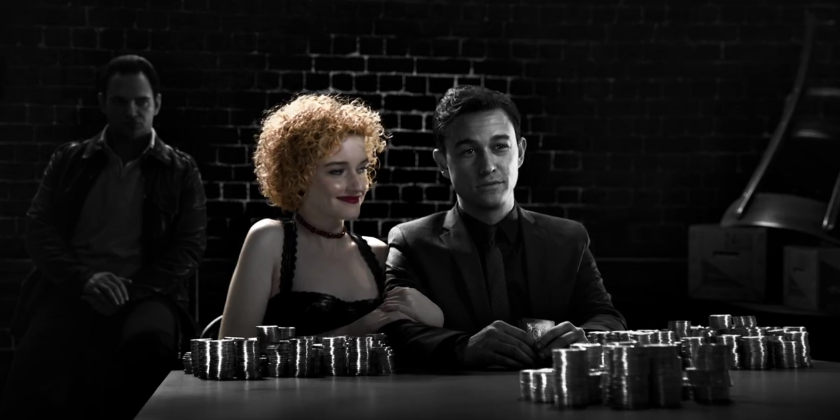Sin City: A Dame to Kill For (2014)
CAST: Josh Brolin, Mickey Rourke, Jessica Alba, Joseph Gordon-Levitt, Eva Green, Bruce Willis, Powers Boothe, Rosario Dawson, Dennis Haysbert, Christopher Meloni, Jeremy Piven, Ray Liotta, Christopher Lloyd, Jamie Chung, Jaime King, Julia Garner, Stacy Keach, Juno Temple, Marton Csokas, Lady Gaga
REVIEW:
Sin City was one of the coolest movies of 2005 (or any other year). Adapted by Robert Rodriguez with painstaking accuracy from Frank Miller’s hyper-stylized, ultra-violent graphic novels, it was a blast of visually inventive, kinetic, wildly over-the-top sadistic fun. For various reasons which vary depending on whose version of events you listen to, it took a whopping nine years for the much-discussed sequel to finally return to Basin City, and like many follow-ups that take this long to see the light of day, it’s dubious whether it was worth the wait. It would be overly harsh to call A Dame to Kill For a trainwreck (though its disastrously abysmal box office returns would argue otherwise), but while it’s diverting, much of the freshness has evaporated. Like other inferior sequels, it remixes a lot of familiar ingredients but without that undefinable “spark”. Dame is not really “bad”, but while it apes its predecessor’s style, it largely lacks its panache, despite moments of flirting with recapturing it.
As in the first film, A Dame to Kill For switches back and forth, not necessarily in strictly chronological order, between four stories, two of which are prequels to ones in the first movie, one a sequel, and one a stand-alone that falls somewhere in between, and while a few characters pop up in more than one, for the most part they are self-contained.
Just Another Saturday Night
Marv (Mickey Rourke) wakes up by the side of the road on the outskirts of the city surrounded by dead men and struggles to remember what happened to him. He retraces his steps through a violent encounter with a sadistic gang of pyromaniac frat boys who meet brutal justice, Marv-style.
A Dame to Kill For
A pre-plastic surgery PI Dwight McCarthy (Josh Brolin, replacing Clive Owen) is lured back in by his seductress ex-flame Ava Lord (Eva Green), who begs for his help escaping her abusive husband (Marton Csokas) and his hulking enforcer Manute (Dennis Haysbert), but Ava may not be the innocent victim she presents herself as. Used and discarded, a scarred and injured Dwight joins forces with Marv and the deadly ladies of Old Town, including Gail (Rosario Dawson) and Miho (Jamie Chung) to storm the Lord mansion and take revenge on his ex-lover.
Nancy’s Last Dance
Sin City’s favorite exotic dancer, Nancy Callahan (Jessica Alba), driven insane by her obsession with the death of John Hartigan (Bruce Willis), becomes determined to avenge his self-sacrificing suicide by wreaking vengeance on Senator Roark (Powers Boothe).
The Long Bad Night
Meanwhile, slick gambler Johnny (Joseph Gordon-Levitt) has his own unpleasant encounter with the Senator when he blows into town with a young stripper (Julia Garner) on his arm and challenges the Senator to a high-stakes poker game. Johnny wins big, but to say Roark is a less-than-gracious loser is a vast understatement, and the cocky Johnny is soon left battered, bloodied, and half-crippled. But “the long bad night” isn’t over yet, and Johnny’s agenda and identity comes with a surprise twist.
Unlike the first film, which took all three of its main plotlines straight from Miller’s pages, often nearly identical shot-for-shot and verbatim, here only the short story Just Another Saturday Night and the titular tale A Dame to Kill For are adapted from the comics, while Miller wrote Nancy’s Last Dance and The Long Bad Night specifically for the movie, neither existing in his graphic novels. This wouldn’t be a problem, except that they feel like shoehorned material to pad out the running length, indicating that perhaps Miller’s creative wellspring has run dry and he already used up his best material the first time around (Johnny’s story seems to run out of steam and not know where to go after an interesting opening, while two out of four stories end repetitively with a villain’s mansion being infiltrated by a crossbow-wielding stripper). We kick things off with Just Another Saturday Night and begin Nancy’s Last Dance and The Long Bad Night before running through the lengthy entirety of A Dame to Kill For before finally getting back to and concluding Johnny and Nancy’s stories, in that order. Just Another Saturday Night serves no real purpose (besides a welcome return for Marv), but it’s short and sweet (playing before the opening credits) and gives us a dose of Marv ass-kicking to set the ball rolling. Unfortunately, the rest of the material is uneven. Johnny’s story starts promisingly but fizzles with an unsatisfying conclusion. Nancy’s revenge feels like tacked-on fanfiction, and after spending the bulk of the runtime on Dwight and Ava’s love-hate shenanigans, her epilogue whisks through too fast to be as satisfying or compelling as it should have been. Actually, despite being a fan favorite ripped straight from the page, the movie’s centerpiece story A Dame to Kill For, which takes up about 2/3 of the runtime, isn’t as tightly-paced or compelling as the first movie’s The Hard Goodbye or That Yellow Bastard, and does a little superfluous meandering, including extraneous time spent on pointless characters like cops Mort (Christopher Meloni) and Bob (Jeremy Piven), saved only from complete tedium by Eva Green vamping it up. Another problem might be the runtime. Despite featuring four stories to the original’s three, A Dame to Kill For clocks in at a slim 100 minutes, significantly shorter than the first movie. I wouldn’t have minded spending more time with Johnny in particular; then again, considering the flimsiness of he and Nancy’s narratives, maybe more wouldn’t have been better.
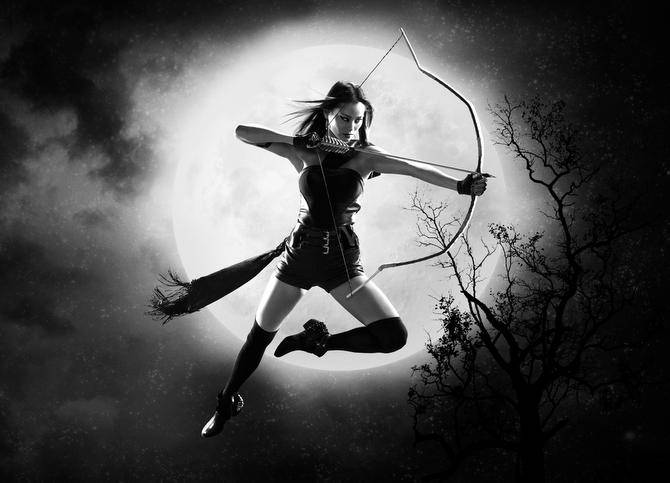 As should come as no surprise, A Dame to Kill For clones its predecessor’s lavish style. Everything is in black-and-white, except for a few striking splashes of color, including Ava’s red lipstick and piercing green eyes, and the stripper Marcie befriended by Johnny colorized in stark contrast to the colorless world around her (recalling the way Jaime King’s Goldie, who makes a brief appearance here, was colorized in the first movie and again here). In certain shots, the glasses of cops Mort and Bob have a whited-out effect that recalls Elijah Wood’s Kevin in the first film. Blood, of which there is copious amounts, is mostly fluorescent white, occasionally red. As before, there are some striking artistic shots, including Miho leaping in front of the moon with crossbow drawn, Johnny’s introductory shot posed against a stormy sky flipping a coin while overlooking the city, and a shot of Eva Green silhouetted naked in the moonlight that should send any Green admirers scrambling to the theater (actually, if you’re a fan of Eva Green’s…assets, this is a must-see for the amount of time she spends naked alone). As before, Marv singlehandedly brutally dispatches a small army of goons (in multiple stories), and “deadly little Miho” does some lopping of heads, all filmed in a cartoonishly over-the-top style that keeps it from getting the NC-17 rating it might have pushed if it played more “straight”. But while on the surface, this looks identical to the original, for some reason it doesn’t “pop” in the same way. At the time, Sin City was strikingly visually inventive and not something we’d seen before. Nine years later, after its style being ripped off by inferior wannabes like The Spirit, the novelty factor is gone, forcing it to rely more heavily on the stories themselves, which aren’t as engaging this time. Additionally, while the first film had a healthy helping of tongue-in-cheek, campy black humor, A Dame to Kill For plays things more straight. There’s not much humor scattered around, resulting in the ride not being as much fun. Even scenes of Marv and Miho slaughtering their way through henchmen feels flat. Even Marv himself doesn’t have the same panache.
As should come as no surprise, A Dame to Kill For clones its predecessor’s lavish style. Everything is in black-and-white, except for a few striking splashes of color, including Ava’s red lipstick and piercing green eyes, and the stripper Marcie befriended by Johnny colorized in stark contrast to the colorless world around her (recalling the way Jaime King’s Goldie, who makes a brief appearance here, was colorized in the first movie and again here). In certain shots, the glasses of cops Mort and Bob have a whited-out effect that recalls Elijah Wood’s Kevin in the first film. Blood, of which there is copious amounts, is mostly fluorescent white, occasionally red. As before, there are some striking artistic shots, including Miho leaping in front of the moon with crossbow drawn, Johnny’s introductory shot posed against a stormy sky flipping a coin while overlooking the city, and a shot of Eva Green silhouetted naked in the moonlight that should send any Green admirers scrambling to the theater (actually, if you’re a fan of Eva Green’s…assets, this is a must-see for the amount of time she spends naked alone). As before, Marv singlehandedly brutally dispatches a small army of goons (in multiple stories), and “deadly little Miho” does some lopping of heads, all filmed in a cartoonishly over-the-top style that keeps it from getting the NC-17 rating it might have pushed if it played more “straight”. But while on the surface, this looks identical to the original, for some reason it doesn’t “pop” in the same way. At the time, Sin City was strikingly visually inventive and not something we’d seen before. Nine years later, after its style being ripped off by inferior wannabes like The Spirit, the novelty factor is gone, forcing it to rely more heavily on the stories themselves, which aren’t as engaging this time. Additionally, while the first film had a healthy helping of tongue-in-cheek, campy black humor, A Dame to Kill For plays things more straight. There’s not much humor scattered around, resulting in the ride not being as much fun. Even scenes of Marv and Miho slaughtering their way through henchmen feels flat. Even Marv himself doesn’t have the same panache.
There are also a number of recasts stemming largely from the passage of time. While Dwight having a different face is part of the story, we also have Dennis Haysbert replacing the late Michael Clarke Duncan, Jamie Chung replacing Devon Aoki as Miho (Aoki quit acting due to pregnancy), and Jeremy Piven replacing Michael Madsen as crooked cop Bob (for unknown reasons). While there’s not that much of a difference between Duncan’s Manute and Haysbert’s, Chung doesn’t look right as Miho after Aoki. The mute Miho might not exactly be a challenging acting role, but Aoki had much more of the deadly little pixie look Miho is described as. There’s not much resemblance between Madsen and Piven’s Bob either, but Bob is a minor enough role that casual viewers probably won’t realize they’re meant to be the same character. The movie’s failure for whatever reason to bring back Clive Owen for the last few minutes of A Dame to Kill For (instead dressing up Josh Brolin in a bad wig and makeup in an ineffectual attempt to make him look vaguely like Owen) is a glaring missed opportunity and a disappointment. While some of the recasts were unavoidable, they undeniably hurt the sense of continuity.
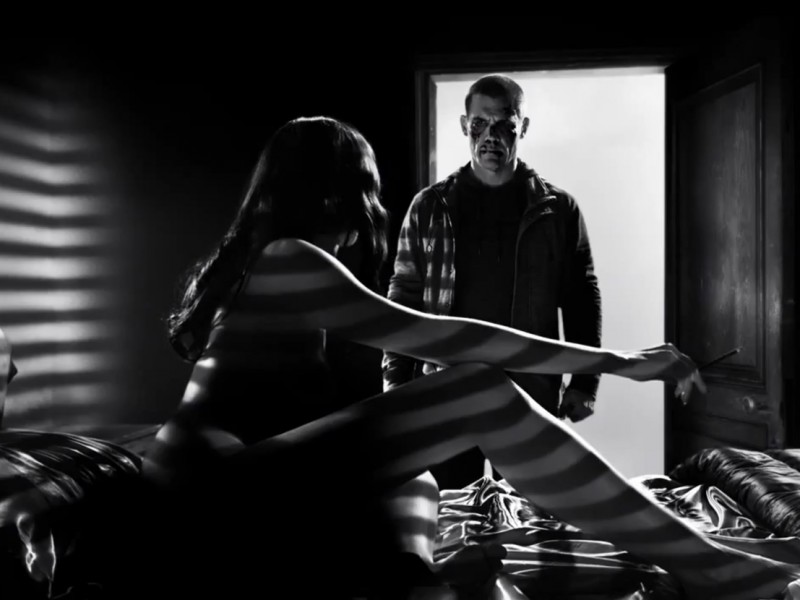 The cast is a mixed bag. Josh Brolin is a believable hardass, but he plays Dwight completely straight as a stone-faced, gravelly-voiced avenger, lacking Clive Owen’s tongue-in-cheek undertone, resulting in the two Dwights not really feeling like the same character. Mickey Rourke makes a welcome return as Marv, but even his gravelly one-liners and ass-kicking feel more obligatory and with less panache, reflecting the overall lack of spark. Marv owned the first movie, but doesn’t make nearly as much impression here, despite being shoehorned into as many stories as possible, even ones where he doesn’t logically belong (most glaringly Nancy’s epilogue, where Marv’s presence makes no chronological sense with the events of the first movie). Bruce Willis has mostly a walk-on role as a ghostly apparition haunting Nancy and discouraging her from seeking revenge. Jessica Alba is okay as long as her job description is limited to sexy dancing, but giving Alba her own story makes her acting limitations which were already evident in the first movie more obvious. At least her story is short enough to not overstay its welcome. On the other hand, Joseph Gordon-Levitt, always an engaging screen presence, is cool, suave, and at least by Sin City standards, sympathetic as Johnny (Gordon-Levitt shows far more charisma than the glumly brooding Brolin), but he’s an interesting character in search of a better story; his bit wanders down a pointless tangent to nowhere that serves nothing but to belabor the obvious point that Senator Roark is a vile scumbag, something which was perfectly clear in his few minute cameo in the first movie nine years ago. Speaking of the Senator, Powers Boothe seems to be enjoying his significantly expanded role this time around, chomping on his cigar and the scenery and making Roark a deliciously detestable villain. The other “big bad” is an even more delicious Eva Green, who makes Ava the perfect femme fatale, savoring her manipulative man-eater with relish. Unlike Alba, who refuses to do nudity despite twice playing a stripper, Green spends about 2/3 of her screentime making it clear she has no such inhibitions. Were it not for the nudity, she’d seem right at home in the kind of ’50s noir thriller Sin City both pays homage to and parodies. Allegedly part of the reason for the delays in filming were that Rodriguez held out for Angelina Jolie to become available for the part before finally moving on, but it’s hard to imagine anyone being better in the role than Green. There are bit parts and walk-on roles from the likes of Ray Liotta (never one to pass up a chance to do some mouth-foaming scenery-chewing), Christopher Lloyd, Juno Temple, Lady Gaga, and Stacy Keach (though Keach’s cameo is unrecognizable). As before, Rodriguez and Miller themselves make cameo appearances.
The cast is a mixed bag. Josh Brolin is a believable hardass, but he plays Dwight completely straight as a stone-faced, gravelly-voiced avenger, lacking Clive Owen’s tongue-in-cheek undertone, resulting in the two Dwights not really feeling like the same character. Mickey Rourke makes a welcome return as Marv, but even his gravelly one-liners and ass-kicking feel more obligatory and with less panache, reflecting the overall lack of spark. Marv owned the first movie, but doesn’t make nearly as much impression here, despite being shoehorned into as many stories as possible, even ones where he doesn’t logically belong (most glaringly Nancy’s epilogue, where Marv’s presence makes no chronological sense with the events of the first movie). Bruce Willis has mostly a walk-on role as a ghostly apparition haunting Nancy and discouraging her from seeking revenge. Jessica Alba is okay as long as her job description is limited to sexy dancing, but giving Alba her own story makes her acting limitations which were already evident in the first movie more obvious. At least her story is short enough to not overstay its welcome. On the other hand, Joseph Gordon-Levitt, always an engaging screen presence, is cool, suave, and at least by Sin City standards, sympathetic as Johnny (Gordon-Levitt shows far more charisma than the glumly brooding Brolin), but he’s an interesting character in search of a better story; his bit wanders down a pointless tangent to nowhere that serves nothing but to belabor the obvious point that Senator Roark is a vile scumbag, something which was perfectly clear in his few minute cameo in the first movie nine years ago. Speaking of the Senator, Powers Boothe seems to be enjoying his significantly expanded role this time around, chomping on his cigar and the scenery and making Roark a deliciously detestable villain. The other “big bad” is an even more delicious Eva Green, who makes Ava the perfect femme fatale, savoring her manipulative man-eater with relish. Unlike Alba, who refuses to do nudity despite twice playing a stripper, Green spends about 2/3 of her screentime making it clear she has no such inhibitions. Were it not for the nudity, she’d seem right at home in the kind of ’50s noir thriller Sin City both pays homage to and parodies. Allegedly part of the reason for the delays in filming were that Rodriguez held out for Angelina Jolie to become available for the part before finally moving on, but it’s hard to imagine anyone being better in the role than Green. There are bit parts and walk-on roles from the likes of Ray Liotta (never one to pass up a chance to do some mouth-foaming scenery-chewing), Christopher Lloyd, Juno Temple, Lady Gaga, and Stacy Keach (though Keach’s cameo is unrecognizable). As before, Rodriguez and Miller themselves make cameo appearances.
When Sin City debuted nine years ago, it made an impression, a visually striking film like nothing we’d ever seen before, overflowing with style, panache, and exuberant excess. The passage of time has tamed these qualities when A Dame to Kill For tries to replicate them. There are moments where it flirts with recapturing the original’s energy level, but too much of it comes across like lesser fan-film. Rodriguez and Miller missed the important advice to strike when the iron is hot; nine years is a long time to expect audiences to wait around for any sequel, and Sin City, while not without its ardent fans, is not the kind of famous comic property with iconic name recognition of Batman or Spider-Man, where the very name is guaranteed to drum up business. If you’re a big Sin City fan (or an admirer of Eva Green, with or without her clothes), A Dame to Kill For has enough merits to be worth a look, but it’s a shame that the film’s assets–the visual style, several strong performances, especially by Joseph Gordon-Levitt, and the deliciously villainous turns of Eva Green and Powers Boothe–were not better-used in the service of stronger material. Ava Lord may be a dame to kill for, but the movie itself doesn’t generate nearly as powerful a reaction.
* * 1/2
